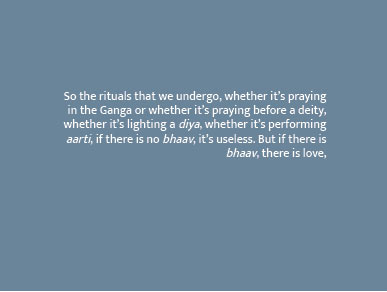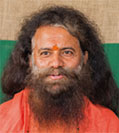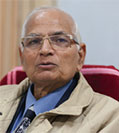- Voices in the book
- Preface
- Maps and Navigation
- Vol 1: Place, Time, Astronomy
- Vol 2: History, Mythology, Belief
- Vol 3: Ganga, Yamuna, Saraswati
- Vol 4: Seva, Sadhana, Satsang
- Vol 5: Guru, Disciple, University
- Vol 6: Abstinence, Penance, Charity
- Vol 7: Faith, Fate, Worship
- Vol 8: Services, Sellers, Spectacle
VOL 3: Ganga, Yamuna, Saraswati
What is the Sangam? The word signifies a confluence, a union of the revered rivers.
Ganga, Yamuna, Saraswati brings together the holy trinity and the sentiments they elicit, which range from keeping the Ganga clean and green to surrendering one’s soul in the waters to emerge pious and pure. Nobody is big or small, rich or poor. At the Sangam, all are one. Myriads of people come to the Sangam for the sacred snan. Be it the akhada members, saints, naga babas, kalpavasis, pilgrims or just visitors who are plain intrigued, each one has their own rituals and beliefs that pay tribute to the river Goddess Ganga.
Contents of place, time, astronomy:
 I rise before the shining one (Poetic Verse)
I rise before the shining one (Poetic Verse) Sadhvi Bhagwati Saraswatiji (Insight)
Sadhvi Bhagwati Saraswatiji (Insight) Ganga, Yamuna, Saraswati (Introduction)
Ganga, Yamuna, Saraswati (Introduction) Swami Chidanand Saraswatiji (Interview)
Swami Chidanand Saraswatiji (Interview) Drops of heavenSant (Photo Story)
Drops of heavenSant (Photo Story)
 Avmuktanandji (Interview)
Avmuktanandji (Interview) Submerge... emerge (Character Story)
Submerge... emerge (Character Story) Naga snan (Reflections)
Naga snan (Reflections) Pandit Krishnanandji (Insight)
Pandit Krishnanandji (Insight) 08.02.2013 (Diary Note)
08.02.2013 (Diary Note)
Excerpts From The Book: sadhvi bhagawati saraswatiji (insight)


Excerpts From The Book: ganga, yamuna, saraswati (Introduction)

Swami Chidanand Saraswatiji quotes, 'When the Ganga saw that the Yamuna was much bigger, she was hesitant to join it. She prayed, “Oh God, when the Yamuna and I meet, I will be lost. The Yamuna is so vast and I am small.” When the Yamuna heard this, she rushed to the Ganga and explained that they would flow together. They are one – neither big nor small. The big ones rush to the small ones; the small ones look up to the big ones. This embracing is the Sangam. It is the reason one should visit the Kumbh.’ Swami Chidanand Saraswatiji is every bit the guruji you come to expect – dressed in saffron, a mop of dense wiry hair and a denser beard through which a melodious voice emanates. As he spreads his message of unity, equality and virtue, it is obvious that he is a man with a mission. His organization, the Ganga Action Parivar, sings an additional tune – decontaminating the Ganga.
Professor of Sanskrit, Hari Dutt Sharma says, ‘This holy river never enquires the castes of the bathers! The Ganga never prevents anyone from taking the dip because he is of a “lower” caste; neither does it promote anyone who is of a so-called “superior” caste.’ Near Qila Ghat, a little area is cordoned off. While innumerable people throng the riverbanks on either side of it, this ghat itself has but a tiny trickle of devotees. Propped on a stick, tilted as if it was bowing to the river, a sign here reads ‘VIP Ghat’. The water is the same; how you get to it is perhaps another story.
Drawing attention to the significance of the shahi snan, Nirbhayadas Kothariji of the Bada Udaseen Akhada says, ‘Auspicious times for the baths are ascertained from the panchanga, the Hindu almanac. The first shahi snan at the Kumbh takes place on Makar Sankranti which is on 14th January this year. The second shahi snan is on Mauni Amavasya or the new moon day in Magh which falls on 10th February this year. The third is Basant Panchami on 15th February. Paush Purnima, Maghi Purnima and Maha Shivratri are also important snan days. The banks overflow with devotees on Makar Sankranti, but that is nothing compared to the numbers that gather here on Mauni Amavasya! The new moon crowd outnumbers the rest by
at least five times more
The Yamuna is mighty, dark and deep; the Ganga is sacred and giving; the Saraswati, mythic. Did you know that in the Rigveda there is only one reference to the Ganga?’ Professor Dubey’s face lights up at his audience’s puzzled expressions. This Professor of Ancient History from the Allahabad University has been studying the Kumbh Mela, among other aspects of Hinduism, since 1980. At the Maha Kumbh Mela, his camp is tucked away in the far side of the Sangam amongst the humble kalpavasis, where camera toting visitors hardly venture. He and his colleagues from the Society of Pilgrimage Studies have camped here for weeks. He praises the Saraswati saying, ‘In the later Vedic period, the Saraswati was known as the Goddess of learning. She comes to Earth in the form of a river. For 11 months of the year, nothing is heard, nothing is seen. For 1 month, in the Hindu month of Magh, she is audible, not visible. She is audible in the form of knowledge expounded by the gurus who come here for the Magh Mela and the Kumbh Mela. And after that, everything vanishes. – Swami Swatmanandji
'The moment you open up a closed space, air flows inside, and the space gets purified. Like air, water is a significant means of purification. Whenever a person takes a snan here, the psychological impact is that all sins are flowing away with the water.’ - Swami Swatmanandji
Zacharie adds, ‘You might wonder why I am doing this if I don’t believe in it. If not for any other reason, I got over my own inhibitions. So, by taking a dip, even if it is not for spiritual or religious reasons, it does something. You step a little outside of what you usually do. I go to school in Massachusetts and Montreal; there are lots of people who are very atheistic and believe there is nothing greater than us humans. I don’t know if religion is real, but when everyone here goes for the snan in the Ganges, they create something bigger for themselves because they are all doing it. It’s something that millions of people do, and, when you think about it, it makes you want to join it.’








